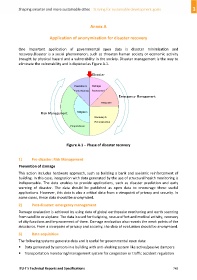Page 753 - Shaping smarter and more sustainable cities - Striving for sustainable development goals
P. 753
Annex A
Application of anonymization for disaster recovery
One important application of governmental open data is disaster minimization and
recovery.Disaster is a social phenomenon, such as threaten human society or economic activity
brought by physical hazard and a vulnerability in the society. Disaster management is the way to
eliminate the vulnerability and is depicted as Figure A.1.
Disaster
Prediction & Damage
Early Warning Assessment
Emergency Management
Response
Risk Management Mitigation
Recovery &
Reconstruction
Preparedness
Figure A.1 – Phase of disaster recovery
1) Pre‐disaster: Risk Management
Prevention of damage
This action includes hardware approach, such as building a bank and aseismic reinforcement of
building. In this case, integration with data generated by the use of structural health monitoring is
indispensable. The data enables to provide applications, such as disaster prediction and early
warning of disaster. The data should be published as open data to encourage these useful
applications. However, this data is also a critical data from a viewpoint of privacy and security. In
some cases, these data should be anonymized.
2) Post‐disaster: emergency management
Damage evaluation is achieved by using data of global earthquake monitoring and earth scanning
from satellite or airplane. The data is used for firefighting, rescue effort and medical activity, recovery
of city functions and improvement of them. Damage evaluation also reveals the weak points of the
structures. From a viewpoint of privacy and security, the data of evaluation should be anonymized.
3) Data acquisition
The following systems generate data and is useful for governmental open data:
Data generated by sensors in a building with anti‐shaking system like active/passive dampers
Transportation monitoring/management system for congestion or traffic accident regulation
ITU‐T's Technical Reports and Specifications 743

